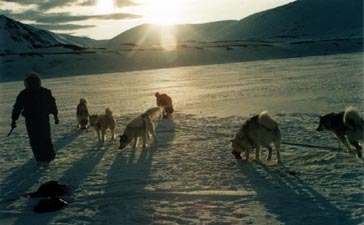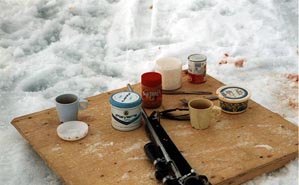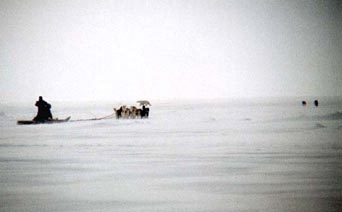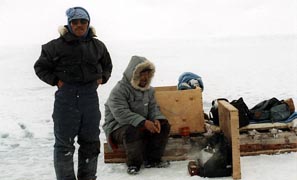Table of Contents
*
Featured Inuit Dog Owner: Chuck Weiss
*
Research Paper 1: Survey of Diseases and Accidents
*
When to Start Working Dogs
*
A Day in the Woods
*
Future or Death
*
Reality Check: Reproduction or the Real Deal
*
Behaviour: Qiniliq Learns His Place
*
High Arctic Mushing: Part III
*
Book Review: Igloo Dwellers Were My Church
*
Janice Howls: All Along the Watch Tower
*
IMHO: Friends and Allies
Navigating This
Site
Index of articles by subject
Index
of back issues by volume number
Search The
Fan Hitch
Articles
to download and print
Ordering
Ken MacRury's Thesis
Our
comprehensive list of resources
Talk
to The Fan
Hitch
The Fan Hitch
home page
ISDI
home page
Editor: Sue Hamilton
Webmaster: Mark Hamilton
Contents of The Fan Hitch Website and its publications are protected by international copyright laws. No photo, drawing or text may be reproduced in any form without written consent. Webmasters please note: written consent is necessary before linking this site to yours! Please forward requests to Sue Hamilton, 55 Town Line Rd., Harwinton, Connecticut 06791, USA or mail@thefanhitch.org

Panueli feeds his team. It's 11 PM Hamilton photo
Mushing in the High Arctic Part III
by Sue and Mark Hamilton
It was easy to loose track of the time. With 24 hours of daylight, we seemed to have altered our biological clocks. The conventional hours for breakfast, lunch and dinner were cast aside. And so, after the previous day's foiled attempt to reach the nesting cliffs, we slept late and lolled around most of the morning. It was noon when we finally headed away from Button Point. We were on the hunt for seals again. The dogs were used to the routine. Once they heard the second shot fired (and there seemed to always be two), even the driver-less team would be up and running. At one such occasion, I was standing a few feet from the qamutiq, not paying attention, when the second shot rang out. I hurtled myself sideways onto the moving qamutiq in front of the utility box just as it slammed into my ribs. It was not as if I would have been abandoned or as if it was any big deal to walk up to a half mile to where the rest of the group would be waiting. It was that sickening fear of disappearing into a well-hidden breathing hole along the way. During this hunt, we took two ring seals and cached their bodies away from the bloody (and therefore attractive) site of the kills. We then dispatched one more seal, taking this one with us to the floe edge. It was five o'clock in the afternoon - already a long day - by the time we reached open water, returning to the exact spot as two days previous.
Inuit love to laugh and joke and tease, and Jayko had a plan. Upon reaching the floe edge he rubbed his hands together in eager anticipation and proclaimed, "I feel like cooking something!" "What might that be?" I asked rhetorically. "SEAL!" he answered. This would be our first meal since well before leaving Button Point and everyone was hungry. Jayko wanted to test us southerners with a sample of his "country food", to see if we would accept it graciously or be grossed out. He didn't know that this wouldn't be our first taste. While Jayko prepared the stove and the cook pot, we scanned the ice edge for wildlife and Panueli set to skinning the seal. He cleverly fashioned the hide into a furry pouch to snugly hold the uneaten parts of the carcass he then butchered. The seal ribs were boiled in a pot of brackish water additionally seasoned with an envelope of tomato vegetable soup. Without hesitation we accepted the parts offered to us. Dark eyes watched intently as we brought the chocolate colored meat to our lips. Dark eyes sparkled with astonishment and pride when we asked for seconds! We sat around completing the meal with peanut butter slathered bannock, mugs of tea and assorted other edibles that didn't seem to complement each other. Then suddenly, Jayko thrust out his arm and pointed to a large object farther up the floe edge, "Look, a bear!"

An Arctic
Smorgasboard
Hamilton
photo
As I said, Inuit love to tease. But this time Jayko wasn't kidding. About a hundred yards to the left (as we faced the open ocean), a male bear estimated to be at least 1200 pounds had hauled out of the water. Our two guides stood calmly as we tourists fumbled furiously to activate our array of photographic gear: Dave and Mark on the video cameras, me with the still camera fitted with a big zoom lens. As motors whirred and shutters clicked and photographers begged beneath their breath "Oh, please don't let my batteries run out now!", the top of the food chain stood looking around. Many glances were cast our way, but at that distance we were more concerned about getting the perfect picture then about the bear's intentions. At the moment he didn't seem to have any. He moved in small circles, appearing to be indecisive. Just as someone muttered "This bear's going nowhere," the animal began to move in from the floe edge. Mindful of our presence, he kept an even distance from us while going farther and farther away from the water. We were too preoccupied to notice, until seen through our cameras' lenses, that very quietly, Panueli had unhooked four of his dogs, who then took off in the direction of the bear. It occurred to all of us simultaneously that the bear was attempting to circle around behind us, positioning us between him and Greenland.
Suddenly, pandemonium broke out! The remaining dogs still hitched started to scream and wander. Our guides picked up their whips and loudly grunted commands to their teams to hold fast. Food, mugs of tea, supplies, began to tumble from the qamutiit. What hadn't been flung off was hastily removed and in a flash, Jayko and Dave were racing on their way after the bear. And before I could say, "Hey, wait for me!", I heard Mark shouting "Good-bye, Sue" as he and Panueli took off after the first team. There was no way those dogs were going to stop once the chase was on and there was no way I was going to make it to a moving sled. So I continued to record the unfolding drama, alternately taking pictures and checking out the action with the binoculars.
Unbelievable! The free dogs set upon the bear, attacking its hind legs, driving it back towards and then into the water. I continued to photograph and watch until all living things disappeared beyond some ice jumbles. It was only then that I realized how alone I felt, standing there next to Nanuq's favorite food, seal fat! It was only then that it dawned on me how easy it would be for the strong swimming bear to, in a few strokes, haul out in my presence with expectations of a warm snack (me) and a tasty seal meal. The camera and binoculars dangled from my neck. Instinctively, I took several steps backwards.
Retreating would not spare me. I had to ready myself and hope that my companions would return before the bear. On the "picnic" table rested the scattered remains of our meal and a rifle, left behind in the rush to chase after the bear. I picked it up, the first time I had even hefted a rifle. As I sighted the heavy weapon, I wondered if the recoil was going to blow me all the way back to camp. Would I break my collarbone? Did it matter? I scanned the floe edge with the barrel, my index finger, numbed with cold, poised on the trigger. Would I be able to kill the bear before it killed me? Would I get in trouble with the authorities for shooting a bear without a permit? The rifle was getting heavier. Would the concussion of the rifle shot crack the thin ice I was standing on? Did it matter? An eternity of minutes passed. And then, from my left appeared four loose dogs and two teams racing like maniacs to my "rescue". The very people who left me for bear bait had come back to "save" me. I didn't know whether to snarl in indignation or wet my polypropylene underwear. After all, I had a rifle and was prepared to shoot to kill. Unfortunately, as my fellow travelers pointed out, I failed to chamber a round into the barrel of the bolt action rifle, so pulling the trigger would have done me as much good as offering the bear a mug up of tea. We packed up the scattered mess and headed back to camp without a visit from the bear. The weather was closing in and we had a long ride back and two dead seals to find if the dogs were going to eat tonight.

Jayko's team and two of Panueli's dogs
head off after
the bear
Hamilton photo
Somewhat inland from the gravel shores of Cornwallis Island there is an area of many tent rings. These formations delineated the campsites of the Thule Culture Inuit. They hunted whale and other marine mammals. When hunting became poor, these ancient peoples moved on, leaving behind the area now occupied by the hamlet of Resolute Bay. That migration occurred about the time that Columbus "discovered" the new world. Aboriginal people of the Arctic have been living on the land for a long time, during these centuries, developing and honing the skills now being exercised by our guides. It was snowing hard. There was no visible landscape much beyond the next dog team, running close by. There was no horizon. The charcoal gray reflection of the open sea against the undersides of the clouds was obliterated. Ice-bound bergs that stood silently watching our passage to the floe edge had become invisible. The trails of many qamutiit dragged by many snow machines and our own dogs had not yet been blown away by the wind, but which set would lead us to our cache of seals and then back to camp? We sat silently as our guides calmly commanded the dogs on a course clearly understood by them alone. All sense of time, place, distance traveled and, of course, direction ceased to exist for us southerners. The weather created in us an eerie sensation, less one of fear than of absolute wonderment. We had faith in our guides and in "our" dogs. Panueli stood fully upright on the front of the moving qamutiq, peering into the whiteout. We peered along with him, as if we were going to be able to discover some landmark that would be helpful to him.
I was sitting on the utility box, looking off to my right when I saw him. We had traveled hours in from the floe edge. Why would he be that far in as well? Then I remembered the tracks we found yesterday near the cliffs and realized it was a possibility. I whipped my head around to Panueli and the dogs. Why hadn't THEY taken note of the hunter whose large black nose and dark eyes loomed in and out of the ice fog and swirling snow. "A bear, A BEAR!" I shrieked, frantically waving my arm to the right. It was impossible to judge distance, especially since the bear kept disappearing and reappearing. Knowing that he could set upon us in a heartbeat, I kept my eyes glued to the dogs. They may not have noticed the bear when I first saw him, but they surely would if he got close enough to attack. Panueli remained focused on “the trail” while Mark and I maintained a state of high alert for the predator. Who would get to the seals first? The dogs began to pick up the pace becoming decidedly more intent. I couldn't tell if they had scented the bear or the seals. After what seemed like an eternity, we stopped at what appeared to us as an unremarkable spot, except that Panueli and Jayko walked over to a pile of jumbled ice and dug out our seals as nonchalantly as I go to my dresser drawer every morning and dig out a fresh pair of socks! We maintained a nervous vigilance while the carcasses were very hastily tied to the back of our qamutiq. With a sense of urgency, the dogs were encouraged onward towards camp, the welcomed sight we finally reached at 11:00 PM.
We quickly set to "undressing" and picketing the dogs, many of whom looked decidedly hungry. Once they were all secured, Jayko and Panueli each took a seal carcass and within tossing distance of their respective teams, began the butchering and feeding process. With knives so sharp they belied the fact that the bodies were rock hard frozen, meat, fat and bone were hacked into chunks and tossed at the dogs, who strained fiercely at their collars. As hungry as they were, there was hardly a fight over which of the paired dogs got what chunk first.
The dogs fed, we gathered in Jayko's tent where a pot of water was already a-boil. For one final time, the now tattered menu was ceremoniously withdrawn from Jayko's pocket, even though we had already decided on chicken, which just happened to be the assigned choice of our outfitter. We chuckled at how pleased he'd be. It was 1:00 AM before we finished eating, washed the dishes and finally crawled deep into our sleeping bags, retreating from both sunlight and stinging cold.

Panueli (standing) and Jayko waiting for
the tea water
to boil. The wooden tack
box top serves as a wind
baffle
Hamilton
photo